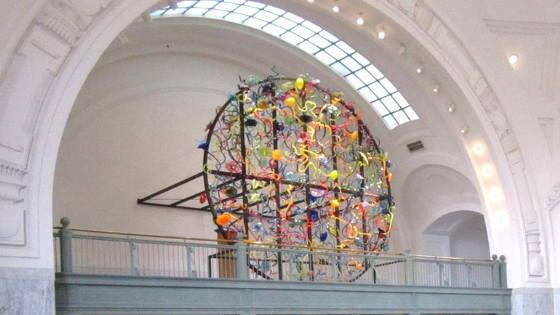Throughout my career as a courthouse planner, I have continually kept in mind the fact that courthouses are not just facilities where justice is administered. Courthouses are also public buildings. I am always inspired when I visit a courthouse that plays an active role in giving back to the public and the local community.
Here are some of my favorite examples involving two ways in courthouse planning that courthouses can give back to the community: displaying local art and providing education on the legal process as a judicial learning center.
Courthouse as an Art Museum
I have found that it is not uncommon for there to be space inside a courthouse that is specifically devoted to showcasing the local arts.
Courthouse Art Exhibit Space
A courthouse I visited several years ago in the Northeast was designed so that its entire lobby is organized as exhibit space. Its atrium permanently accommodates several large colorful paintings created by a local artist, as well as a rotating art collection from several community organizations.
Similarly, a spacious lobby that I toured in a courthouse in the Mid-Atlantic plays host to jugglers, musicians, and craft vendors as part of the city’s annual New Year’s Eve celebration. The court administrators and employees were also proud to describe public events that have been held in their courthouse throughout the year including food and wine tastings, historical re-enactments, philharmonic events, and even yoga classes!
Courthouse as a Judicial Learning Center
On a recent visit to a courthouse in Mid-West, I discovered that the court is actively involved in what I believe to be one of the most important things they can offer to the community: children’s education. The courthouse contains a judicial learning center that was specifically designed to educate young students about the role of the judiciary. It contains a small courtroom with interactive modules, where students are taught about the various components of a courtroom. Descriptions of the roles of the judge, jurors, witnesses, and attorneys are provided in simple and fun terms; all in the context of the history of the judicial system in America.
Courthouse Judicial Learning Center
As I passed by a group of students being led into a session about how a jury is selected, I noticed a wall full of post-it notes. The notes were hand written by students who had already been through the learning center, and they were filled with words like “awesome” and “cool.” Perhaps the students who visited the courthouse to learn about the importance of the judiciary, left with the inspiration to one day make a difference in the field of law.
 Courthouse Wall of Post-it Notes
Courthouse Wall of Post-it Notes
Court administrators in another Mid-West courthouse have also partnered with area school districts to make their courtrooms available for mock trial competitions. Mock trial is an extracurricular activity for high school students where students from opposing schools serve as prosecutors, defense attorneys, and witnesses for fictitious cases. The students are introduced to the process of conducting a trial, and are afforded the opportunity to experience a real courtroom. This is an inspiring benefit to a student who is considering a career in law.
Courthouse Mock Trial Participants
It is satisfying to see public facilities, like courthouses, being used by the community for the enjoyment of art, entertainment, and education. Does your courthouse provide opportunities for your community?







.jpg)
.jpg)
.jpg)
.jpg)
.jpg)
.jpg)


-1.jpg)
.jpg)
.jpg)

